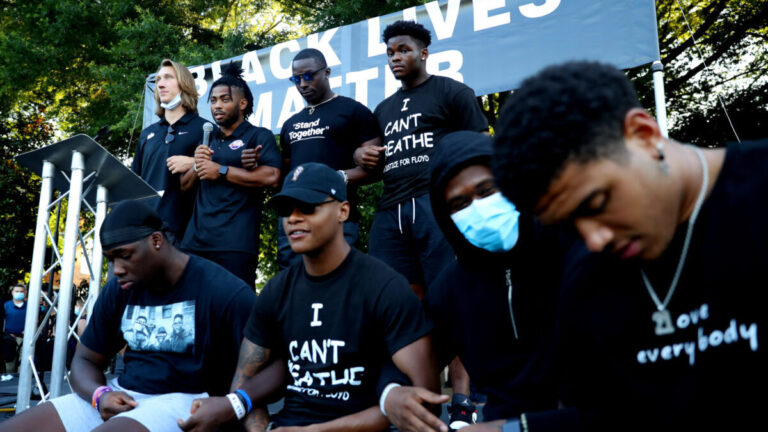On Or Off, A Field Of Consequences
Why this matters
In order to comprehend the financial losses as a result of COVID-19 to college sport, it is important to understand just how valuable college football is in terms of revenue it brings into their university.
Every year thousands of student-athletes take the field, court, or pitch in numerous different sports in conferences such as the Big Ten. They have worked relentlessly to earn a division I scholarship and pursue a further education along with development in their sport. Unfortunately, 2020 has brought forth the unique challenge of forcing universities to decide whether or not to play a fall season in the midst of the Covid-19 pandemic. The Big Ten made a bold statement by becoming the first power-five conference to cancel their fall football season back in August. However, in a dramatic reversal, the conference has recently changed course and decided to go ahead with a potentially shortened season starting in October. With the potential season looking likely, it is intriguing to look into the financial implications a canceled football season would have on Big Ten universities.
In order to comprehend the financial losses, it is important to understand just how valuable college football is in terms of revenue it brings into their university. One fact remains certain, which is that football is the largest contributor to Big Ten universities’ athletic revenue. In the last two years alone, college football nationally brought in around $3 billion, with a large portion of that figure coming from power-five conferences such as the Big Ten. One of the most lucrative aspects of this business is the number of fans the sport attracts for its games. The three top average attendances for the 2019 college football season were all Big Ten universities, with the University of Michigan leading the way by averaging 111,459 fans per game, followed by Penn State and Ohio State at 105,678 and 103,383, respectively. As a result, the loss of revenue solely from ticket sales, merchandise, tailgating and concessions will already create a significant change to the overall revenue brought in for these universities. Even in the shortened season that is becoming likely, there is a high possibility that all this revenue could be lost as fans in many sports are either not allowed or only allowed to a certain capacity.
However, another massive chunk of the college football revenue comes in the form of television contracts. The Big Ten conference’s revenue jumped 48% from fiscal year 2017 to bring in nearly $759 million in 2018. A new contract with Fox Sports was one of the largest factors in that record year-over-year increase. With the decision to cancel the 2020 fall football season, this revenue will consequently take a massive hit. It is also important to keep in mind that while football is the largest revenue generator for collegiate athletic programs, they are far from the only sport that is dependent on that revenue. Teams such as men’s and women’s volleyball, tennis, track and field as well as numerous other non-revenue generating sports will have to adjust course and adapt as a result of the Covid-19 pandemic’s effect on the college athletics landscape.
Men’s and women’s soccer is one of those sports that were also not planning on taking the field this fall. The struggle of dealing with student-athletes who have dedicated their entire youth to get the opportunity to play at a division 1 level is not lost on Northwestern University men’s soccer coach Tim Lenahan. Right off the bat, Lenahan cited some major changes that fall athletic teams are having to make. As an example, teams are allowed to train but must remain non-contact for the time being. In addition, student-athletes are given the option to opt-out of these training sessions due to health concerns. While this is a meaningful mandate as it shows the conference and its individual universities are putting their student-athletes' health first, it certainly makes it challenging for staff to come up with productive training plans. Fortunately for Lenahan, they have not had staff furloughed yet but that is another possibility as the lack of football revenue forces teams into extremely tight budgetary situations. Lenahan described some of these difficulties, saying, “All expenditures need approval, and even the roster size will likely have to be reduced as well with caps on the number of players.” Clearly this is a potentially damaging effect of the COVID-19 pandemic on collegiate athletics, as it may end up taking away the dream of playing at a top university from numerous potential recruits down the line. However, there is still hope among Lenahan and coaches alike that some form of a spring season will happen, which will still provide some financial comfort to athletic teams that are currently tightening their budgets.
Another potential long-term side effect of canceling the fall football season is the fact that it could turn avid fans away for years to come. Once the decision was announced by Big Ten Commissioner Kevin Warren there were protests not only among fans but also by parents of Big Ten football players. One of those parents was Randy Wade, father of an Ohio State football player, who said, “We want to do everything we can to play in the fall. We don't like the way the decision went down by the presidents… Our kids wear Big Ten on every jersey.” Not only is it difficult to prevent student-athletes from playing the sport they love, but it also could affect their abilities to continue playing at the next level, the NFL. For many of these top football programs, that is a major area of concern.
So why does this all matter? It seems that there are plenty of negative consequences to canceling the fall Big Ten football season. However, according to Big Ten Commissioner Kevin Warren and the chancellors of the Big Ten universities who voted to make that difficult initial decision, none of these consequences are more important than the health and safety of their student-athletes. In an open letter to the Big Ten community, Warren stated clearly, “Financial considerations did not influence the COP/C decision, as the postponement will have enormous adverse financial implications… At the core of our decision was the knowledge that there were too many unknown health risks regarding SARS-CoV-2 infection and its impact on our student-athletes.” The ability to conveniently and accurately test and monitor COVID-19 within its student-athlete population was at the forefront of the minds of those making the initial decision to cancel the fall season.
However, with recent upgrades to testing that would allow for rapid-testing results to its student-athletes, along with a stringent return to play protocols after a positive result that require each student-athlete to recover for 21 days before returning, the Big Ten leaders felt comfortable that they can field a football season while still maintaining the highest possible regard for the safety of its student-athletes, coaches, and staff. Whether it was the social pressure to have a season, the addition of advanced testing technology or the financial implications of not having a football season that pushed officials to reverse their decision will not be known by the public, all that is known now is that the Big Ten will most likely be back on the gridiron this fall.
Monthly Issue
The Reset of College Sport
Sport at the college level in America is facing issues reflective of the world at large. From the calls for racial equality, labor disputes and discussions, to health and safety concerns with playing in a pandemic - what will this reset moment look like?





